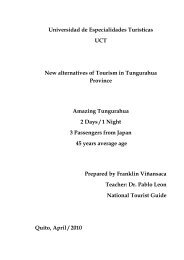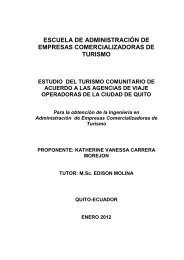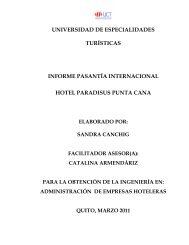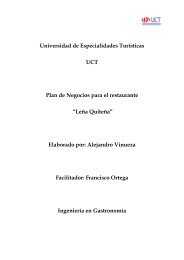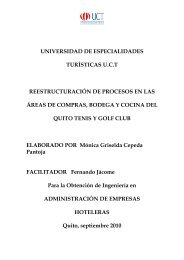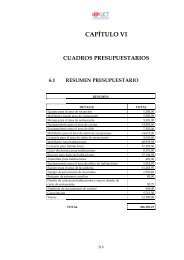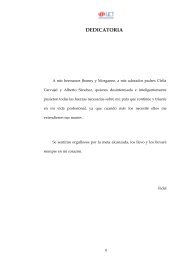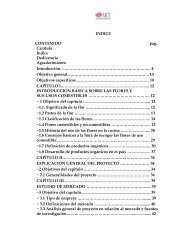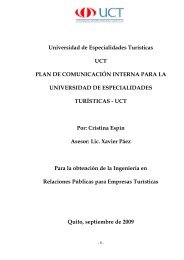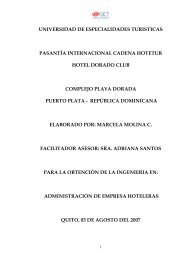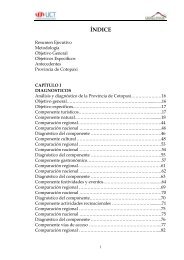Universidad de Especialidades Turísticas - Repositorio Digital UCT ...
Universidad de Especialidades Turísticas - Repositorio Digital UCT ...
Universidad de Especialidades Turísticas - Repositorio Digital UCT ...
Create successful ePaper yourself
Turn your PDF publications into a flip-book with our unique Google optimized e-Paper software.
<strong>Universidad</strong> <strong>de</strong> Especialida<strong>de</strong>s <strong>Turísticas</strong><br />
<strong>UCT</strong><br />
”ADVENTURE SPORTS”<br />
Quito, January 3, 2006<br />
1
<strong>Universidad</strong> <strong>de</strong> Especialida<strong>de</strong>s <strong>Turísticas</strong><br />
<strong>UCT</strong><br />
”ZONA EXTREMA”<br />
ADVENTURE SPORTS:<br />
Provinces: Pichincha<br />
Imbabura<br />
MADE BY:<br />
Miss. Erika Andra<strong>de</strong><br />
TEACHER:<br />
Mr. Fernando Cal<strong>de</strong>rón<br />
Tourism National Gui<strong>de</strong> Quito, December 17, 2005<br />
2
GRATEFULNESS AND DEDICATION<br />
After finishing my university studies career, I thank to the<br />
people who have helped me, to finish it successfully; first to<br />
my family: to my father, eternal example whose work, ma<strong>de</strong><br />
with love is an affluent work and has been the example of gui<strong>de</strong><br />
throughout my preparation, to my mother and sister who<br />
always to the distance gave me strength to go ahead until<br />
today.<br />
To the authorities and teachers, those who today I have the<br />
pri<strong>de</strong> to treat like friends. Thanks for their patience, <strong>de</strong>dication<br />
and support.<br />
To the three professionals who ma<strong>de</strong> of my <strong>de</strong>gree a pleasant<br />
work and worthy to be remembered, along with the people<br />
who contributed their sand granite to conclu<strong>de</strong> this work.<br />
THANKS are the only word that today arrives at my mind to<br />
thank for their time and affection, but I promise in my<br />
professional life to <strong>de</strong>monstrate that their efforts have been<br />
worth for me.<br />
Erika.<br />
3
REPORT<br />
We have tourists (7) <strong>de</strong>scendants of North American and English. With<br />
ranks of ages of 30 to 45 years and a passenger of third age, 65 years.<br />
The motivation from their visit to Ecuador is to practice adventure sports<br />
in the provinces of Pichincha and Imbabura, in two days that they have<br />
available time. Two organized options of tours have been sent to them,<br />
which appear next; with the eagerness of which their expectations and<br />
exigencies are fulfilled, in the required time and places.<br />
4
OPTION A<br />
PRIVATE SERVICES TOUR<br />
INCLUDES<br />
Transport<br />
Feeding (day one: box lunch)<br />
Fare entrance to established places<br />
Equipment to practice sports (rafting, oar, horse riding)<br />
Tour Gui<strong>de</strong> and specialized gui<strong>de</strong>s in sports of adventure<br />
Drinks at the end of the tour<br />
DOES NOT INCLUDE<br />
Lodging<br />
Breakfasts and suppers<br />
Extra telephone Calls<br />
Drinks<br />
5
DAY ONE ITINERARY:<br />
06:30 Departue from Quito to arrive at the shores of Toachi river.<br />
09:00 Arrival at Tinalandia, long walk by the established footpaths<br />
10:00 Exit from Tinalandia<br />
10:10 Arrival at Valle Hermoso to change clothes<br />
10:45 Talk about security and practices of oar at the arrival at the river.<br />
THREE HOURS river down, plus a shutdown for a <strong>de</strong>licious picnic at the<br />
shore of the river at 27 km from the beginning. At the end of the trip we will<br />
enjoy relaxation preparing us to our following day a little.<br />
19:30 Estimated time of arrival to Quito<br />
20:00 Check in at Reina Isabel Hotel (hypothetical Destiny)<br />
6
DAY TWO ITINERARY:<br />
07:30 Departure to Otavalo city, in the province of Imbabura<br />
09:30 Arrival to the ponchos market in Otavalo<br />
10:30 Arrival to San Francisco farm<br />
10:30 Practice of Horse Back Riding<br />
13:30 Departure to Otavalo<br />
13:50 Arrival to Otavalo<br />
14:00 Lunch in Otavalo<br />
15:00 Departure to San Pablo Lagoon.<br />
16:00 Short walk and practice of oar<br />
17:00 Departure to Quito city.<br />
18:30 Arrival<br />
7
OPTION B<br />
PRIVATE SERVICES TOUR<br />
INCLUDES<br />
Transport<br />
Feeding (day one box lunch)<br />
Fare entrance to established places<br />
Equipment to practice sports (rafting, oar, horse riding)<br />
Tour gui<strong>de</strong> accompanying and specialized gui<strong>de</strong>s in sports of adventure<br />
Drinks at the end of tour<br />
DO NOT INCLUDE<br />
Lodging<br />
Breakfasts and suppers<br />
Extra drinks<br />
telephone Calls<br />
8
DAY ONE ITINERARY :<br />
The same as Day one itinerary of Option A.<br />
DAY TWO ITINERARY:<br />
08:00 Breakfast<br />
09:00 Horse back riding<br />
12:00 Departure to Otavalo<br />
12:30 Lunch<br />
13:30 Departure to San Pablo lagoon.<br />
14:30 Practice of oar<br />
16:00 Departure to Quito city.<br />
17:00 Arrival<br />
9
ACTIVITIES JUSTIFICATION<br />
OPTION A<br />
ACTIVITIES JUSTIFICATION. DAY 1:<br />
The motivation of the passengers of our tour is to make adventure sports in a small<br />
country, with a great amount of options of that type but that offers all the pertinent<br />
securities, and, as a sport that offers security, adventure and nature, with the<br />
following option: The selected activity for day one is a <strong>de</strong>scent ion in Toachi and<br />
Blanco rivers since they are rivers of third and fourth category, <strong>de</strong>pending on the<br />
season of the year in which the trip is ma<strong>de</strong>. In addition, they are rivers that allow<br />
to make their <strong>de</strong>scent ion with tourists, are a fantastic introduction to the rivers of<br />
Ecuador; beginning from the western si<strong>de</strong> of the an<strong>de</strong>s they have one of the longest<br />
navigable parts of crystalline water rivers in Ecuador. This combined with the<br />
signals and sounds that the forest provi<strong>de</strong>s, we will be able to guarantee a full day of<br />
adventure and worthy to remember.<br />
LODGING JUSTIFICATION<br />
The operations centre of our tour for moving facilities will be in Quito City (capital<br />
of Ecuador), place from which we begin our trip. The essential reason by which it<br />
chooses to Quito like operations centre and lodging, is because the first day , our<br />
route is to the nor-western part of the country taking it as reference t, and the second<br />
day we start going North being the same datum point, both doing a trip by car,<br />
about two hours with thirty minutes like time average, sufficient time trip by car<br />
due to the conditions after a day of physical wearing down.<br />
Quito is the centric place by which we must cross once conclu<strong>de</strong>d the first day, and<br />
since we cannot make a so long trip (5 hours approx.) in or<strong>de</strong>r to arrive in our city of<br />
<strong>de</strong>stiny for two days, since we must protect the physical state of the fleeting tourists,<br />
gui<strong>de</strong>s and driver, a scale is ma<strong>de</strong> in the city that presents the optimal conditions for<br />
the case: in addition, because it is located between the trip <strong>de</strong>stinies for day one and<br />
day two, helping us in this way for the operation of the following day.<br />
In Quito there are hotels for different budgets; from hotels five stars to inns that<br />
offer good bed and breakfast; and ad<strong>de</strong>d to this the city has architectonic<br />
characteristics that complement a justified way by the capital becoming the best<br />
option of lodging in the route.<br />
10
DAY TWO ACTIVITIES JUSTIFICATION:<br />
WHY HORSEBACK RIDING? The main reason why I chose horseback<br />
riding for day two is based on the predisposition of the tourist for the second day of<br />
the trip, since the first day, they a full adrenalin activity, which was organized to<br />
fulfil their expectations of adventure sport, and the second day, since we have a<br />
third age in the group, we will try, as much as possible to have a good time in the<br />
activity that is programmed for the other passengers, but to their level of exigency,<br />
without seeing themselves forced to wear away too much energy. In a few words,<br />
they will be able to measure their strength after a day consi<strong>de</strong>red very hard, as the<br />
previous day; and they will relax and enjoy a calm horse riding.<br />
Taking into account to the rest of passengers who without doubt still have<br />
strength to enjoy a very intense day, they will be able to ri<strong>de</strong> their horses at the<br />
capacity they impose on the reins of their horses, with the complete security that they<br />
have an enabled person who could gui<strong>de</strong> them on the handling of their horses<br />
during the three riding hours; in that way, the second day, they will enjoy it at their<br />
own rhythm.<br />
11
OPTION A PROGRAM:<br />
DAY ONE PROGRAM:<br />
SECTION QUITO-SANTO DOMINGO DE LOS COLORADOS<br />
Santo Domingo <strong>de</strong> los Colorados, for its location is a city great relevance in the<br />
province of Pichincha, because it is located in a strategic site between the mountain<br />
range and coast.<br />
The zone where Santo Domingo <strong>de</strong> los Colorados is located does not present a great<br />
irregularity, because its settlement extends along a large zone of plains. The rivers<br />
that stand out in the area are: Toachi and Blanco that are used for the practice of<br />
rafting and constitute an attractiveness for the zone. Rivers of smaller rank we can<br />
mention: Diablo, Guasai, Agua Clara, Popusa, Cucaracha, Congoma and Salapi.<br />
The temperature in the area oscillates between the 18 to 24 <strong>de</strong>grees Celsius. As Santo<br />
Domingo is in a warm zone, this is cover by exuberant vegetation, and we can<br />
mention some speacies like: raft, husk, rubber, Sandia, palms, carob trees, cinnamoncoloured,<br />
chonta, vegetal ivory (Tagua), among others. The agricultural activity is<br />
<strong>de</strong>veloped very well in the zone, because there are farms <strong>de</strong>dicated to the banana<br />
tree production, coffee, sugar cane, rice, African palm, manila, beans, achiote,<br />
oranges, passion fruits, papayas, grapefruits, naranjilla, among others.<br />
In the fauna of the area we can distinguish: birds like: exotic parrots, woodpeckers<br />
and animals like:, tigrillos, guantas and great variety of serpents among others. In<br />
addition Santo Domingo is a zone of great importance for the cattle industry.<br />
12
Tourist Attractions:<br />
Cultural:<br />
Park Joaquin Zaracay, with the monument to the Great Tsáchila.<br />
Tsàchila Community: settled in the thick vegetation of Santo Domingo, via Quevedo<br />
it is the home of the Tsáchila community, ethnic group that fights to maintain their<br />
famous traditions and by its rituals of treatment.<br />
Their clothing are very showy and colorful, the men wear: a two-color called<br />
Manpechampa (this can be blue-white or black-white), Nanun Panun is a red<br />
handkerchief which is hung from the shoul<strong>de</strong>r and the Sendori (a red handkerchief<br />
tied to their waist ) their hair painted of red, with oil gotten from the seeds of achiote<br />
(on the head, they wear a white hairband called Mishiri). Women wear the tunan (<br />
colorful strips skirt) and kachi donun (handkerchief that covers their breasts). Their<br />
Language is the Tsafiqui<br />
At the moment, 3500 Tsáchilas are organized in eight communities , one of the<br />
meeting places of the Tsáchilas is the Uni-shu, ceremonial stone in the Baba river,<br />
there the Colorados go to be thankful to Pipoa (God of the sun rays) and Mapiyan<br />
(lagoons spirit). When they have a celebration the Tsáchilas go to Panpa, for the<br />
Kasama ( New Year celebration).<br />
Tsachila means: True Man<br />
13
DAY TWO PROGRAM:<br />
SECTION QUITO – OTAVALO<br />
Quito - Otavalo<br />
Our meeting will be very early in the morning to go to Otavalo, at 95 km from Quito.<br />
Firstly we will take the Pan-American road, that is consi<strong>de</strong>red the column one of<br />
Ecuador since it crosses our country from North to South. In the route we will find<br />
small towns like:<br />
Cal<strong>de</strong>rón<br />
In the northwest of Quito at a height of 2671 m.s.n.m. which is famous in all<br />
Ecuador mainly, by the elaboration of figures of mazapán and by the funeral customs<br />
of their inhabitants.<br />
Guayllabamba<br />
At 30 km from Quito, this town has propitious An<strong>de</strong>an tropical climate for<br />
agriculture standing out fruits like custard apple, at a height of 2132 m.s.n.m. In<br />
addition it is very well-known by the gastronomy, and its 30 species of mammals<br />
and 21 of birds that there are in the zoo.<br />
Tabacundo<br />
Cantonal Head of Pedro Moncayo, where the tourist will find meadows full of corn,<br />
roses, blackberries and wheat, closely together, is the entrance of the Ruins of<br />
Cochasqui, to find the Tolas there are 8Km. until arriving at the museum.<br />
14
Cayambe<br />
It is 77 km far from Quito city (40min), it is a town characterized by its beautiful<br />
landscapes, among others, we can see Cayambe volcano at 5790 msnm. Cayambe is<br />
settled in a valley surroun<strong>de</strong>d by cattle properties and is famous by the cheese<br />
elaboration and in addition by the preparation of biscuits.<br />
One of the most important properties is Guachalá Inn located at 70 kilometres from<br />
Quito on the Pan-American north, the entrance to the property is by the town of<br />
Cangahua. Cultivating flowers constitutes a non traditional exportation product<br />
and it occupies the fifth place among the products that contribute to the economy of<br />
the country with 3.79% of the budget, after petroleum, bananas, tourism and shrimp.<br />
They have two types of cultivation: The Green House that consists in maintaining<br />
the plantation un<strong>de</strong>r a plastic cover supported by a metallic or wood structure;<br />
where only roses are cultivated.<br />
The other one is outdoors, only for Summer flowers like: Sunflowers, Gipsofila,<br />
Estatus, Crisantemos, Cartridges, Liatris, Hypericum.<br />
It is necessary to remark that this activity generates many jobs, but also affects to the<br />
health of the workers by the chemical substances used.<br />
The flowers production activity, occupies the fourth place in the exportations of the<br />
country, only in Pichincha it generates 16,553 jobs, and at national level 25.000.<br />
15
IMBABURA PROVINCE<br />
Historically their inhabitants were the Imbayas and Cayambis, soon dominated by<br />
the Caras, the convergence of these, would allow the birth of the Caranquis that<br />
would resist to the Inca invasion.<br />
The province was created on June 25, 1824, inclu<strong>de</strong>d the present territories of<br />
Carchi province.<br />
In 1880 the present territories took shape. It is located to the north of the Ecuadorian<br />
territory, in the western Hoya of Chota. It limits the north with the Boliche knot ,<br />
and to the South by Mojanda Cajas Knot.<br />
In its very fertile valleys there are cities and town, like: Ibarra, Otavalo, Cotacachi<br />
and Chota; their main elevations are Imbabura (4560 ms), Cotacahi (4.944m), and<br />
Yanaurco <strong>de</strong> Piñan (4,535 ms). Chota river marks the limit between the provinces of<br />
Imbabura and Carchi, on its route there is a great variety of plantations of ovitos. The<br />
nosdt important rivers that flow in Chota are: Salinas, Salado and Pisque.<br />
Other remarkable rivers in the province are those that <strong>de</strong>scend from Dacha and form<br />
Ambí river, that increases its volume with Tahundo and Blanco rivers, which flows<br />
in Chota river to form Mira river, in limits with the province of Carchi. To the<br />
Northeast of the province we find part of the Ecological Reserve Cotacachi-Cayapas,<br />
and at the Southwest, part of Ecological Reserve Cayambe Coca.<br />
The climate of the province is: An<strong>de</strong>an, cold tempering An<strong>de</strong>an and the provincial<br />
temperature varies according to the zone, although its value average is around the<br />
18 <strong>de</strong>grees Celsius.<br />
San Pablo Lake<br />
Its located 35 km to the Southeast of the center of Otavalo.<br />
On the centigra<strong>de</strong> feet of sacred volcano "Taita Imbabura" with a <strong>de</strong>pth of 48m. and<br />
temperature of 8º, occupying a tectonic grave, 4 km long and 3 wi<strong>de</strong>, is Imbacocha<br />
lagoon ( native name ), surroun<strong>de</strong>d by Totora, with which the native make the totora<br />
ponies which are used for the transport by the lagoon, this material is used also for<br />
the elaboration of baskets and mats.<br />
16
Otavalo community<br />
Otavalo community is located in the center of the province of Imbabura, the city has<br />
the same name..About the origin of Otavalos, like human group, they themselves<br />
think that they come from Mitimaes, even though, they also say that they are Imbaya<br />
- Caranqui. The community takes the name from the place where they live. Its<br />
language is quichua, although at the present time many of them speak Spanish,<br />
English and French.<br />
Nowadays, their subsistence is based on agriculture and in the elaboration of crafts,<br />
specially textile, where they offer their products to the national and international<br />
market on Saturdays in the Ponchos Market, the Otavalos are the more known<br />
ethnic group of Ecuador all over the world.<br />
It is important to mention the manufactures, that they produced with cotton and aloe<br />
fibre (abaca or cabuya ) that provi<strong>de</strong>d all the colony with canvas shoes ( alpargatas) ,<br />
bags, wicks, mounts, hats, etc., which forced to the natives to work forcedly.<br />
Animal market<br />
the animal market has a great importance, since it reflects the original commerce<br />
which the natives had before the colony and during the colony by means of the<br />
exchange, interchanging products.<br />
Every early Saturday in the morning, the city, the indigenous of the town and the<br />
mestizos ( a mixture of races meet with in single intention, the sale of their animals.<br />
Ponchos Market:<br />
the ponchos market has been a very attractive place from old times when the natives<br />
of the zone left to exhibit their weaves, mainly clothes, when they obtained profits,<br />
they began to produce other types of weaves and to sell too, not only to the people<br />
of the community but also tourists that began to visit this fair attracted by their<br />
weaves, crafts and by the typical colorful fair.<br />
The fair is every day Saturdays on the corner of Sucre and Salinas streets, from 7 in<br />
the morning.<br />
17
REPORT AND APPROVAL OF THE WORKING PLAN:<br />
Once ma<strong>de</strong> the study of the necessities of the group of tourists to whom we focused<br />
and with previous study of activities and statistics - annexed volume the <strong>de</strong>cision to<br />
plan tour with the option previously presented. In the itinerary, the tour satisfies the<br />
search of adrenalin the tourists had with a <strong>de</strong>scent ion along Toachi which is about<br />
200 km of clear water apt for rafting for non-professional.<br />
The second day there is horse riding and the style of day one changes totally but it<br />
does not stop being interesting cause there are: sports, adrenalin, and relaxation. In<br />
or<strong>de</strong>r to conclu<strong>de</strong> the tour we will practice oar in one of the most visited lagoons<br />
from all Ecuador, around which there is good tourism infrastructure like Port Lake,<br />
Cabañas <strong>de</strong>l Lago, etc.<br />
One practices aquatic sports like Sailing, Water bikes, as well as swimming etc.<br />
The lodging is ma<strong>de</strong> in the city, at the beginning of tour since it is downtown and<br />
offers very good possibilities of lodging for all the social levels from 5 stars to good<br />
bed and brekfast, and gives us the possibility of going to the two extremes of the<br />
country with distances and similar times without forcing the tourists to be on the<br />
vehicle of transport, doing more comfortable the trip.<br />
18
ANNEXED<br />
ADVENTURE SPORTS:<br />
Are the set of sport activities, generally of recent creation, whose practice implies a<br />
greater danger for the integrity of the medical instructors who normally established.<br />
In fact, good part of the risk sports <strong>de</strong>rives from classic sport activities, and is<br />
fomenting their <strong>de</strong>velopment by the possibilities that its sponsorship offers, to the<br />
being including in thematic chains of television.<br />
Also it has contributed to its practice the sport material appearance, that in many<br />
occasions <strong>de</strong>velops variants of another one that existed already.<br />
It is also remarkable the appearance of Guiness Records book which from its<br />
creation has fomented the practice of more or fewer sports and fundamentally<br />
peculiar activities.<br />
In the United States, the set of sport activities of risk is grouped un<strong>de</strong>r the name of<br />
CARRIES FAR GAMES, that from mid of the <strong>de</strong>ca<strong>de</strong> of 1990 have been able to group<br />
itself in annual festivals<br />
RAFTING<br />
Rafting began to be practiced as sport in 1869, when John Wesley organized the first<br />
expedition to the Colorado river, the United States, by boats with central oar.<br />
At the beginning, the adventurers did not have any technique to manoeuvre the rigid<br />
boats in the rapids and had problems like bell rounds and collisions against rocks.<br />
During 60s, 70s, and 80s rafting with the creation of new lighter materials were<br />
impelled, nowadays there are around 1000 companies of rafting scattered by the<br />
world.<br />
In Ecuador we have rivers of Third to Fifth categories, the river that we will sail is a<br />
river category III and certain sections IV.<br />
19
HORSE BACK RIDING<br />
From century VXI with the arrival of the Spaniards, several animal species were<br />
introduced to our territory, that was occupied by the Incas before, among the<br />
introduced species are the horses that through the time have become an animal that<br />
serves like:<br />
loading for which in Inca stage, the Lamas were <strong>de</strong>stined<br />
transport of people<br />
Sports<br />
And we are in<strong>de</strong>ed going to focus in this last activity, since we are going to practice<br />
horse riding in a property of the mountainous area, that will not offer an incredible<br />
landscape to us but also the possibility of being connected with the animal of the<br />
kings; called in that way since the kings practice pole from childhood.<br />
ACTIVITIES THAT CAN BE MADE IN ECUADOR<br />
Since Ecuador is a rich country in nature and proudly the most mega diverse<br />
country of the world, thanks to its different ecosystems, the possibility of practicing<br />
extreme sports has become one of the strengths to increase the tourism in the<br />
country.<br />
For that reason we mentioned some of the sports that are offered in our territory;<br />
which information a tourist who visits us could have access to enjoy that in our<br />
territory the best way.<br />
Kanoping; A new activity in the country, is ma<strong>de</strong> from a tower at several meters of<br />
height that besi<strong>de</strong>s being a viewpoint of hundreds of species of birds that are the<br />
essential characteristic in the zones where it is ma<strong>de</strong>, also it is taken advantage to<br />
tend cables from the tower to the ground, cables by means of which with the aid of a<br />
harness and the aid of people totally enabled we will <strong>de</strong>scend in a few seconds,<br />
enjoying an unforgettable experience.<br />
20
Trekking: In Ecuador there are several places prepared for this sport since it is<br />
possible to be ma<strong>de</strong> in protected areas like: Pasochoa, Cajas, Cotopaxi, etc and<br />
infinity of places that have footpaths planned for long or short duration.<br />
Voying: Activity that can be ma<strong>de</strong> in Mindo and the city of Baños, it consists in<br />
<strong>de</strong>scending by the river on buoys tied firmly, at the speed that the current imposes.<br />
Water Ski: Sport that can be ma<strong>de</strong> in the Province of Imbabura in San Pablo lagoon<br />
in the mountainous area and it is also offered as beach sport of the Ecuadorian coast.<br />
Climbing: In Ecuador there are ample zones of Volcanoes <strong>de</strong>nominated like the<br />
avenue of volcanoes, we own a part of new volcanism <strong>de</strong>stined to do climbing in<br />
snowed peaks of up to 6310 meters of height as Chimborazo is (highest volcano of<br />
Ecuador)<br />
Biking: It is a sport that is mainly ma<strong>de</strong> in the mountainous area, in inns and<br />
properties that have land extensions, and enabled gui<strong>de</strong>s and the necessary<br />
equipment.<br />
21
NOTE: In following annexes the affluence of tourists, it is <strong>de</strong>monstrated who make<br />
rafting and their age average.<br />
Practicantes Rafting Porcentual cada 3 Meses<br />
30%<br />
10%<br />
3era Edad<br />
Adultos<br />
Jovenes<br />
60%<br />
Source: Data base Yacu Operating Amu of Rafting<br />
Place of the survey: Provinces of Pichincha and Napo<br />
Date: 2004-2005<br />
Because we have a person of third age in our group of tourists, by means of this<br />
graph I want to <strong>de</strong>monstrate that rafting in spite of being a sport of massive<br />
acceptance by the tourists of third age, not taking into account the effort that this<br />
needs; it has welcome of consi<strong>de</strong>rable way. Making of this an apt sport to be<br />
ma<strong>de</strong> with a no homogenous group as far as ages one talks about being this our<br />
case.<br />
22
Personas Practicantes <strong>de</strong> Rafting cada 3 Meses<br />
60<br />
50<br />
40<br />
30<br />
20<br />
10<br />
0<br />
Enero - Marzo Abril - Junio Julio -<br />
Septiembre<br />
Octubre -<br />
Diciembre<br />
3era Edad<br />
Adultos<br />
Jovenes<br />
Source: Data base Yacu Operating Amu of Rafting<br />
Place of the survey: Provinces of Pichincha and Napo<br />
Date: 2004-2005<br />
By means of the graph it is <strong>de</strong>monstrated like target towards which the operators<br />
of this sport focus are adult people (25-40 years) and who throughout a year have a<br />
non massive but consi<strong>de</strong>rable affluence of people of third age. In the values it is<br />
not mentioned children since of operative specifications and levels they are not in<br />
favour apt for the sport without with that exceptions do not exist.<br />
23
CONCLUSIONS<br />
After having a practice we verified that the physical activities must go away<br />
evaluating throughout the route, since they <strong>de</strong>mand a consi<strong>de</strong>rable physical<br />
wearing down.<br />
The consi<strong>de</strong>red times were quite successful counting with misfortunes like<br />
traffic on the highway, rest and basic learning of the handling of equipment<br />
and techniques of the specified sport.<br />
The selected activities were ma<strong>de</strong> without bad happening during the days of<br />
tour, but a relaxing activity and time to rest each day, as example, a visit to<br />
thermal waters of the area that would help to renew energies for returning to<br />
the two city bases or operations centre of the project.<br />
Although the specialized gui<strong>de</strong>s who accompanied to us handled their work<br />
in a satisfactory way, the accompanying gui<strong>de</strong> or national gui<strong>de</strong> must know<br />
all the pertinent information to be able to suggest, without becoming jumbled<br />
in the net part of the specialized gui<strong>de</strong><br />
The handling of tour is total responsibility of the national gui<strong>de</strong>, as verifying<br />
the correct unfolding of tour, and the fulfilment of the offered thing by the<br />
agency that provi<strong>de</strong>s equipment and gui<strong>de</strong>s in each sport.<br />
If this tour were ma<strong>de</strong> by a more homogenous group, it would have a<br />
highest acceptance; since a person of third age needs more time to rest and<br />
relax, but without forgetting that the request and motivation of the trip<br />
<strong>de</strong>mand certain physical training conditions that the satisfaction of the<br />
tourist guarantees total success of tour along with.<br />
24
BIBLIGRAPHY<br />
www.tinalandia.com<br />
www.google.com (for rafting, paddle information, and communitarian tourism)<br />
www.yacuamu.com<br />
www.runatupari.com<br />
personal interviews with tourism operators and specialized gui<strong>de</strong>s<br />
personal back up<br />
25



